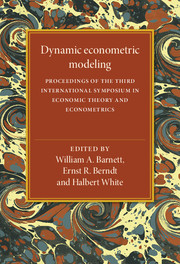 Dynamic Econometric Modeling
Dynamic Econometric Modeling Book contents
- Frontmatter
- Contents
- Editors' introduction
- List of contributors
- Part I Dynamic structural modeling
- Part II Linear time series modeling
- 8 A central-limit result for instrumental variables estimators of linear time series models
- 9 Exact and approximate distribution of the t ratio test statistic in an AR(1) model
- 10 The use of ARIMA models in unobserved-components estimation: an application to Spanish monetary control
- Part III Chaotic attractor modeling
- Part IV Applications
10 - The use of ARIMA models in unobserved-components estimation: an application to Spanish monetary control
Published online by Cambridge University Press: 03 May 2010
- Frontmatter
- Contents
- Editors' introduction
- List of contributors
- Part I Dynamic structural modeling
- Part II Linear time series modeling
- 8 A central-limit result for instrumental variables estimators of linear time series models
- 9 Exact and approximate distribution of the t ratio test statistic in an AR(1) model
- 10 The use of ARIMA models in unobserved-components estimation: an application to Spanish monetary control
- Part III Chaotic attractor modeling
- Part IV Applications
Summary
Time series analysts (often “econometricians”) working in institutions involved with economic policy making or short–term economic analysis face two important professional demands: forecasting and unobserved components estimation (including seasonal adjustment). Estimation of unobserved components is overwhelmingly done in practice by using ad hoc filters; the most popular example is estimation of the seasonally adjusted series with the Xll or Xll ARIMA program.
Concerning forecasting, the decade of the seventies witnessed the proliferation of autoregressive integrated moving–average (ARIMA) models (Box and Jenkins 1970), which seemed to capture well the evolution of many series. Since this evolution is related to the presence of trend, seasonal, and noise variation, the possibility of using ARIMA models in the context of unobserved components was soon recognized. Since the early work of Grether and Nerlove (1970) on stationary series, several approaches have been suggested. I shall concentrate on one that is becoming, in my opinion, a powerful statistical tool in applied time series work [starting references are Cleveland and Tiao (1976) and Box, Hillmer, and Tiao (1978); more recent references are Bell and Hillmer (1984) and Maravall and Pierce (1987)]. In the context of an application related to the control of the Spanish money supply, I shall address the issues of model specification, estimation of the components, diagnostic checking of the results, and inference drawing.
Information
- Type
- Chapter
- Information
- Dynamic Econometric ModelingProceedings of the Third International Symposium in Economic Theory and Econometrics, pp. 171 - 196Publisher: Cambridge University PressPrint publication year: 1988
Accessibility standard: Unknown
Why this information is here
This section outlines the accessibility features of this content - including support for screen readers, full keyboard navigation and high-contrast display options. This may not be relevant for you.Accessibility Information
- 2
- Cited by